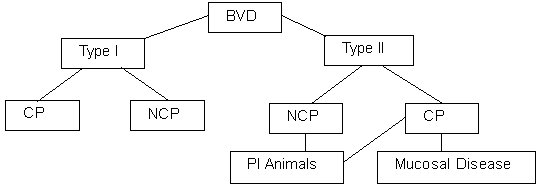
Causative Agent:
BVD is the name of a group of diseases in cattle of all ages that are caused by the Bovine Viral Diarrhea virus. The virus has at least two strains, Type I and Type II; and two biotypes, cytopathic (CP) and noncytopathic (NCP). Infected animals are also classified as persistently infected (PI) or have the mucosal form of the disease. PI animals are ones that were infected before birth and survived. PI animals continually shed the virus throughout their lives, contaminating other animals and the environment.Clinical Signs: The NCP biotype is often responsible for abortions, birth defects, respiratory disease, and PI offspring. The CP biotype is usually found in animals with mucosal disease. Animals with the CP biotype eventually die, showing signs of hemorrhage (blood) from the rectum and areas of hemorrhage in the membranes of the mouth and vulva. Type II BVD is most often associated with PI animals and mucosal disease. See the chart below.

Calves infected after birth are often dull, weak, feverish, and have diarrhea. Adults may have fevers, diarrhea, decreased milk production, oral lesions, and nasal discharge.
Disease Transmission: The virus usually enters through the nose or mouth from direct contact with infected animals or by contact with contaminated objects (boots, vehicles, etc.). When a pregnant animal is infected, the virus spreads to the fetus causing an abortion, defects, or PI animal.
Diagnosis: Virus isolation of BVD from tissue samples or from an aborted fetus can be used to identify infected animals or herds. Blood samples can be used to find titers and signs of infection. Recent studies indicate that BVD can be detected from milk samples using PCR amplification. New skin tests are available that detect PI animals.
Prevention: Aggressive vaccination programs, utilizing a combination of modified live and killed vaccines, are effective in preventing and controlling the disease. However, these vaccines may not totally prevent fetal infections. Therefore, it is recommended that infected and PI animals be identified and culled as soon as possible.